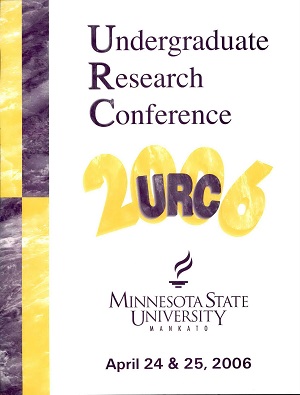Analysis of Pit Features from the Silvernale Site
Location
CSU North Ballroom
Start Date
24-4-2006 10:30 AM
End Date
24-4-2006 12:30 PM
Student's Major
Anthropology
Student's College
Social and Behavioral Sciences
Mentor's Name
Ronald Schirmer
Mentor's Department
Anthropology
Mentor's College
Social and Behavioral Sciences
Description
Precontact Native Americans discarded waste into pits near their house or village. Refuse pits become darkened areas in the soil due to concentrated organic material, which can be identified and studied. Analysis of the refuse materials shows the resource usage patterns of a cultural group. The seasons in which the site was occupied, the resources being used, and the people's interaction with other groups and their environment can all be determined by analyzing these pits. Such information is valuable in determining the social, cultural, and economic aspects of the peoples inhabiting a site, and in studying culture change.
Refuse pits excavated at the Silvernale site in Red Wing, Minnesota, inhabited between A.D. 1050- 1250, offer the opportunity to shed light on this poorly-known period in the region. Some of these pits were found to be superimposed over other, older pits suggesting multiple occupations of the site. The question then becomes does multiple occupations mean occupation by different cultural groups? The best way to answer this question is to analyze the remains of the pits to determine if the resources were used in similar ways or whether they indicate the presence of different cultural groups.
Analysis of Pit Features from the Silvernale Site
CSU North Ballroom
Precontact Native Americans discarded waste into pits near their house or village. Refuse pits become darkened areas in the soil due to concentrated organic material, which can be identified and studied. Analysis of the refuse materials shows the resource usage patterns of a cultural group. The seasons in which the site was occupied, the resources being used, and the people's interaction with other groups and their environment can all be determined by analyzing these pits. Such information is valuable in determining the social, cultural, and economic aspects of the peoples inhabiting a site, and in studying culture change.
Refuse pits excavated at the Silvernale site in Red Wing, Minnesota, inhabited between A.D. 1050- 1250, offer the opportunity to shed light on this poorly-known period in the region. Some of these pits were found to be superimposed over other, older pits suggesting multiple occupations of the site. The question then becomes does multiple occupations mean occupation by different cultural groups? The best way to answer this question is to analyze the remains of the pits to determine if the resources were used in similar ways or whether they indicate the presence of different cultural groups.
Recommended Citation
Juen, Joel. "Analysis of Pit Features from the Silvernale Site." Undergraduate Research Symposium, Mankato, MN, April 24, 2006.
https://cornerstone.lib.mnsu.edu/urs/2006/poster-session-A/6



